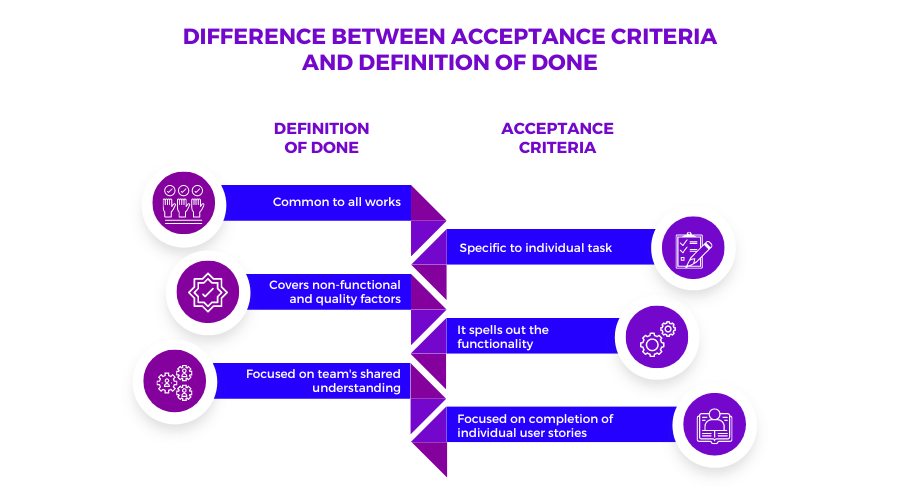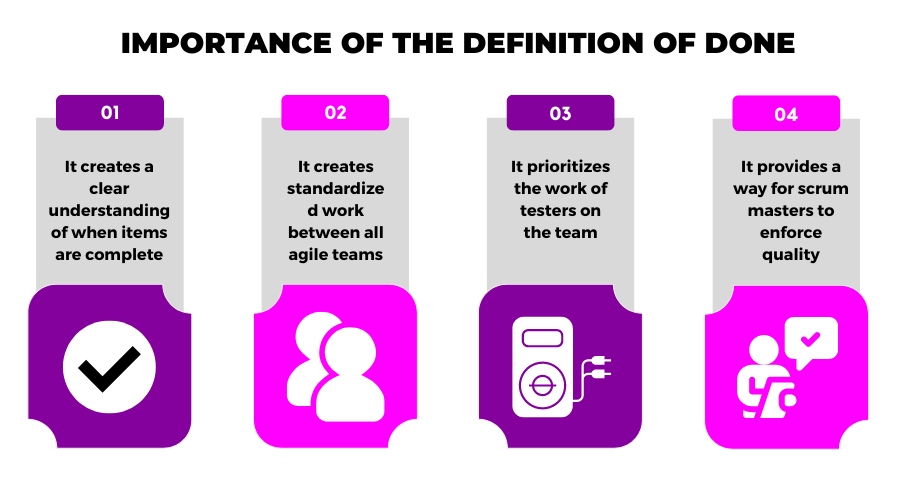What Is Definition of Done and Who Creates it? (Good Example Discussed)
June 29, 2021 Max 6min read

What Is the Definition of Done?
Definition of Done, also abbreviated as DOD, is a set of terms that needs to get completed before a task or completed backlog. The product owner, scrum master, and the development team establish this set of terms in advance.
When the Definition of Done gets used consistently, it serves as a boundary between tasks in progress and complete tasks.
A common understanding of product ethics is to secure the quality, which you can establish by the Definition of Done.
In the scrum framework, it is common to label tasks as epic, user story, backlogs, and features to understand the criteria of each task.
When Definition of Done gets successfully implemented, it gives a higher speed to the development team. Hence Definition of Done is crucial when using product management tools.
Who Creates the Definition of Done?
When it comes to the Definition of Done (DoD) in Scrum, it falls on the Scrum Team to create and agree on it during the Sprint Planning event.
This team comprises the Product Owner, Development Team, and Scrum Master, who work together to define requirements, develop a plan, and set goals for the Sprint.
The Definition of Done is an essential outcome of this event as it outlines the criteria that must be met for each Product Backlog item to be considered complete or “Done.”
It’s worth noting that the Scrum Team collaboratively creates and agrees upon the Definition of Done to ensure it is well-defined, easily understood, and followed by all team members. Following the DoD is crucial to produce a high-quality Sprint Increment and ultimately achieving customer satisfaction.
Definition of Done vs Acceptance Criteria
The scope of the Definition of Done and admission criteria are different. While the term “done” refers to all of your work, acceptance criteria are specific to individual pieces of work, such as user stories and PBI in some situations.
In agile, the Definition of Done creates transparency for your team’s common knowledge. Knowing what has to happen with any item to complete meets the useable standard.
In other words, the Department of Defense identifies the requirements for an increment to be published.
On the other side, acceptance criteria are concerned with openness and the steps required to fulfill a single user story.
Other distinctions include:
DoD includes both functional and non-functional aspects.
Acceptance criteria determine capability and the consequences that this functionality provides to users.

What Is the Importance of the Definition of Done?
Let us look at the importance of Definition of Done, now that you have a solid understanding of what DoD is all about.
Leaving the question of whether anything is “done” open to interpretation can lead to disagreement. It also leads to misunderstandings, unpleasant user experiences, and income implications.
It is a solid reason to decide on that criteria before the sprint starts. Sharing a similar vision for the ultimate product is an excellent place to start any project.
Choosing the gates that a feature must pass through to complete gives a sense of anticipation.
Another advantage of not giving each project its meaning of “done” saves time and allows people to focus on creativity and execution rather than definition.
Therefore taking the time to establish a baseline understanding of what “done” means to everyone is worthwhile.
With the ambiguity gone, everyone can focus on their primary responsibilities. Rather than debating readiness for release later in the process.
Furthermore, even if a feature appears to be complete on the surface if the technical team hasn’t marked the i’s and crossed the t’s behind the scenes.
The resources will continue to come back to those “completed” projects to clean up and handle open problems.

How to Create a Definition of Done?
Gather the Right Individuals:
It would help if you created the Definition of Done with input from the entire scrum team.
If different teams are working on the same project, everyone should be involved.
Stakeholders should quickly access an increment that fulfills the criteria of done so that they can provide feedback on it.
Determine The Work:
Before any changes to the product may include a new increment, have the participants specify all that is required. Remember that an increment is usable and quickly evaluated by stakeholders.
A sticky note gets used for each work item (physical or virtual). Make your statement as specific as possible.
If someone on your team says “testing,” be precise about what that means and make sticky notes like:
- There is an automatic regression test for each acceptance criteria.
- All acceptance and regression tests were successful.
- More than 80% of unit tests get covered.
- All unit tests were successful.
There were no “event blockers” discovered during manual exploratory testing.
Place all the sticky notes (again, physical or virtual). Continue to inquire whether extra work is required.
Are there any signatures? Updated documentation? Are there any legal requirements? The crew will ultimately have captured everything. You’ve arrived at your definition of done.
How Frequently Should You Do It?
Let’s see how often the team believes fresh increments can get created.
Place the labels on the wall as follows:
- Almost Every Check-In
- Every item in the Product Backlog
- Every single day
- Each Sprint
- Occasionally (less than once per sprint)
Taking A Look At The Definition Of Done:
Suppose any sticky notes have the “Less Than Once Per Sprint” section.
In that case, the team cannot satisfy their definition of done every sprint, and this is a key stumbling block for scrum’s inspect and adapt cycles.
As a starting point, the team may use a rudimentary Definition of Done that only covers work you can accomplish inside each sprint.
The work required to be valuable and accessible to stakeholders got included in the above-mentioned exercise’s Definition of Done.
If launching the product needs more than just pressing a button, document the work involved in putting something fresh into production. Label it “Release Work” and hang it on the wall.
Modifying the Definition of Done:
Every change should meet the criteria of done, and the release cost should be nearly zero. It helps the company to realize the new value swiftly.
The longer a team waits between increments, the more likely it will encounter problems. Early detection and treatment of problems are more manageable than late detection and treatment.
What Is a Good Example of Definition of Done?
One of the best definition of done examples in software would be this: “Done implies coded to standards, reviewed, implemented using unit test-driven development, tested with 100% test automation, integrated, and documented.”
In the context of services, “done” might indicate every task under the user story is now complete. Any work performed has been attached to the user story so the product owner can evaluate it and ensure it fulfills their expectations.
DoD guarantees that everyone on the team is aware of the expectations for everything they produce. It ensures that the product and organization are transparent and of high quality.
Furthermore, shifting tickets to done increases team motivation and efficiency.
You may also be interested in:
FAQs
The Definition of Done, commonly known as DOD, is a collection of requirements laid down before a task or backlog you consider complete. It is a collection of terms established in advance by the product owner, scrum master, and the development team.
The team creates the Definition of Done. However, if the team lacks clear development criteria, the Scrum Master may be required to enforce quality limits.
During the sprint retrospective, the development team can revise the definition of done.
